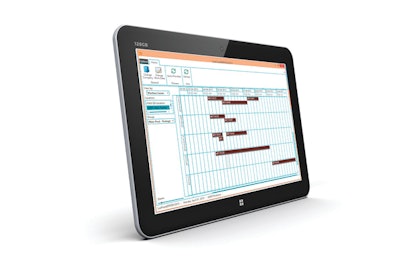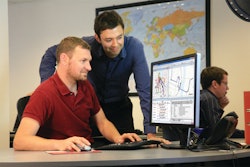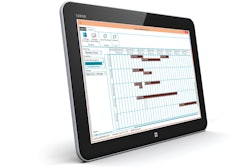
There was a business term a couple of decades ago known as “management by walking around”—meaning, a boss who visits the office, shop floor and warehouse to see what’s actually going on with employees, machines, inventory and day-to-day processes. A modernized version of “management by walking around” is the boss who has a tablet, smartphone or other mobile device in his hands—and so do his employees! Today it’s “production by walking around,” “warehousing by walking around” and “quality assurance by walking around,” too.
Mobile technology is a game changer across all segments of society right now, and the food industry is no exception. Having access to transactional data and real-time metrics, at the very spots where this information is needed, is today a reality, and coming down in price all the time as mobile apps, cloud/software-as-a-service (SaaS) business models and other flexible options revolutionize the industry’s adoption of technology.
Perhaps when you think of enterprise resource planning (ERP) software systems, mobility isn’t the first attribute that springs to mind. It should be … your business doesn’t live only in the back office with no one getting up from their desktop computers—and neither should your ERP software.
Zdnet.com wrote in December 2013: “What is defining success in ERP now is how well companies connect their people and systems to all manner of constituents (e.g., customers, machines, prospects, etc.) and all kinds of technologies (e.g., machines, handhelds, mobile devices, etc.).” We like this description so much we coined the term, “connective ERP” from it—that is, the business of connecting your employees, machinery/equipment, information, processes and procedures easily to each other to maximize efficiencies and real-time responses.
Imagine any (or all) of the following scenarios, and ask yourself if your business would be more profitable if they existed:
- Line workers can see exactly what’s going on in production before it’s too late to correct the batch.
- Forklift drivers can update the warehouse management system without getting off their machines.
- A quality assurance (QA) manager can put select inventory on hold whenever and wherever, and let everyone in the company know about it right away.
Game changer. Game changer. Game changer.
Companies can now benefit from web-based technology that extends functionality to handheld devices such as barcode scanner guns and mobile applications that display your vital data via mounted tablets on the shop floor. Some of the resulting benefits include: safety and quality compliance supported; improved inventory visibility and accuracy; real-time, on-the-spot metrics; and overall efficiency boosters, such as mobile printing in the warehouse and real-time recording of production activities.
Let’s break down the concept of connective ERP by department in a food company (leaving out the obvious work that ERP software does in accounting, sales and marketing, and purchasing). The web client is revolutionizing ERP—bringing it into places at work it’s never been able to go before—the production floor, the warehouse, the QA walk-around.
Mobile Production
Real-time recording of production activities—such as output, consumption, and precise calculation of yield and actual costs—can be immediately analyzed for immediate improvements. Corrections can be made right in the production line, in time to avoid any serious repercussions. Imagine if production transactions could be accessed quickly and easily through mobile devices using a mobile application that talks to your ERP system. Transactions could also include:
- Pallet license plates; country of original labeling (C.O.O.L.); product labels and batch tickets via mobile printers.
- Product specifications and work instructions.
- Production schedule work center to-do lists.
- Rules-based input prompts.
- Integrated results from weigh scales and other equipment.
- Progress dashboards with on-the-spot metrics.
Food safety and quality compliance is supported because mobile ERP allows for more timely and accurate tracking of inventory—enhancing bidirectional traceability across the supply chain.
It’s Always All about UI
User interface (UI) is always the deal breaker/maker in technology—and that is true, too, for mobile technologies rocking the food industry. Because key performance indicators (KPIs) are so vital to efficiency, their visual display (UI) has to be the best it can be; handheld devices do not always lend themselves to more customizable data, nor integration with weigh scales and other equipment. However, KPIs can be displayed and integrated on a wash-down touchscreen computer, or displayed on a tablet set up at the front or end of a production line. Employees can easily digest the KPIs—expected vs. actual component usage, output and costs, yield, capacity, etc. —right where they are needed the most.
Today there are graphical tools—extensions to ERP—that allow visibility into all machines and data on the shop floor, so that faster, more accurate decisions can be made about production. Automation logic enforces sequencing rules for items such as allergens, flavors and colors, and solves critical production issues before they cause problems. An example of this kind of ERP-extended graphical tool is an application that allows for drag-and-drop production (re)scheduling on a tablet, as well as single-click auto-prioritizing, visibility of correlations between work-in-process (WIP) and finished goods; and visual clues about allergens, colors and production statuses.
Mobile Warehousing
Warehouse management systems (WMS) no longer need be bulky, separate software that must be integrated with your ERP system at great pains and cost. In fact, WMS does not even need to be restricted to the back office anymore, but rather, can be extended to bin-level transactions through radio frequency (RF) and mobile devices connected wirelessly to the network.
With inventory at the heart of your operations—and your profitability—the ability for employees to manage, control and accelerate functionality on the warehouse floor is critical.
Warehouse workers can use mobile devices—such as barcode scanner guns and forklift-mounted tablets—to perform their daily tasks, including:
- Quick product lookups by item, bin and lot numbers—critical for traceability and recall processes.
- Pick efficiency: Pick sequencing eliminates guesswork on higher-level inventory bins.
- Stock rotation: A barcode scanner allows for visibility and easy FEFO-directed picking regardless of where items are located in the warehouse.
- Optimized accuracy (statistics on picks) and velocity of customer order fulfillment.
- On-the-spot physical counts.
- Receiving and warehouse put-aways.
- Printing of barcode labels when and where they are needed.
Mobile QA
Keeping up with the growing demands for quality compliance and certification, such as the GFSI standards, SQF and BRC, is difficult to achieve with manual, paper-based tracking. Just how timely and accurate can quality processes and procedures be if employees have to rifle through binders of documents, which may be illegible and missing in some cases, type that information into an Excel spreadsheet or other format, and then conduct analyses?
QA and QC data, procedures and processes integrated into the ERP system mean that employees can initiate and capture quality data electronically for real-time visibility, sharing and taking critical actions—anywhere in the company. Quality assurance employees can do their jobs walking the shop floor, the warehouse, and/or the research and development (R&D) lab by entering data right into their handheld devices as they go, with the resulting benefits:
- Initiated at various stages of material movement (such as receiving, output or shipping), quality audits can be captured electronically and in real-time using mobile devices.
- Lot blocks can be automated as soon as a quality audit is created; the audit is linked, within the ERP system, to each specific transaction related to the blocked lot.
- Quality holds are created by employees within the ERP system, and only users with security rights can release or move a hold. Additional tests can be linked to the quality hold.
- Automatic audits are triggered by transactions, e.g. receiving audits, carrier audits. Upon a raw goods delivery, a warehouse receipt document is entered into the ERP system and a quality audit automatically pops up on the screen to be filled in.
- Electronic verification that an audit has been completed correctly is triggered, including a digital signature step if required.
- There are quality holds of food products ordered immediately upon detection of any issues.
- Accelerated traceability, via single-button trigger, supporting the product recall process.
- All data is linked together, so users don’t need to look in different places for the information relating to quality.
- There are suggestions of audits based on calendar frequency, such as GMP audits, with associated planning worksheets.
- Unlimited quality tests or standard operating procedures (SOPs) can be set up related to items, customers, vendors, assets, employees or other business entities.
Having access to transactional data and real-time metrics in situ is no longer a “nice to have”; to compete in an industry in which profit margins can be pretty slim, your company needs to investigate the full range of functionality of any ERP system. Can all necessary data and metrics be accessed by required employees in real time on their mobile devices including forklift-mounted tablets, smart phones, touchscreen devices and barcode scanner guns?
We are at a time in history in which ERP software is the furthest thing from an unwieldy beast that crouches in the back office. Connective ERP means accessing all your data from anywhere—shop floor, back office, warehouse, quality lab, on the road—and productivity never has to miss a beat. Handheld devices on wireless networks work with web clients through ERP systems to move information to people, places and machines (some call it the Internet of things) ...
It’s a brave new world—and it’s all about connection.



















